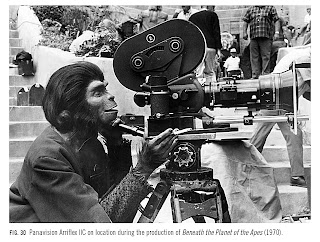 Chronicle of a Camera: The Arriflex 35 in North America, 1945-1972 provides a history of the most consequential 35mm motion picture camera introduced following the Second World War: the Arriflex 35. Author Norris Pope traces the North American history of this camera from the end of the war up through 1972—when the first lightweight self-blimped 35mm cameras became available.
Chronicle of a Camera: The Arriflex 35 in North America, 1945-1972 provides a history of the most consequential 35mm motion picture camera introduced following the Second World War: the Arriflex 35. Author Norris Pope traces the North American history of this camera from the end of the war up through 1972—when the first lightweight self-blimped 35mm cameras became available. The book shows that the Arriflex’s impact proved particularly marked in three areas: in the encouragement the camera provided for location shooting, in the options the camera gave cinematographers for intensifying visual style and content, and the ways in which the camera made possible low-budget and independent production.
 The Arriflex was ultimately responsible for changes in the style and content of American feature films, especially in the 1960s. Because the Arriflex was lightweight and highly portable, its use expanded the range of production choices, styles, and even content of American motion pictures. The period examined in the book culminated most strikingly in examples found in feature films dating from the 1960s and early 1970s, including a number of films associated with what came to be known as the “Hollywood New Wave.”
The Arriflex was ultimately responsible for changes in the style and content of American feature films, especially in the 1960s. Because the Arriflex was lightweight and highly portable, its use expanded the range of production choices, styles, and even content of American motion pictures. The period examined in the book culminated most strikingly in examples found in feature films dating from the 1960s and early 1970s, including a number of films associated with what came to be known as the “Hollywood New Wave.” Some of the films discussed by Pope in which the Arriflex played an absolutely central role include Bullitt, The French Connection, and, most significantly, Easy Rider. The application of the Arriflex in car-mounted shots, hand-held shots, and zoom-lens use led to greater cinematic realism and personal expression in these films.
Chronicle of a Camera also features 40 illustrations showing how the Arriflex was used on various movie sets.
Chronicle of a Camera will be available next month from UPM. The book can be previewed now on NetGalley.






Comments